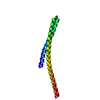[English] 日本語
 Yorodumi
Yorodumi- PDB-8wb7: CryoEM structure of Snf7 N-terminal domain in the inner coils of ... -
+ Open data
Open data
- Basic information
Basic information
| Entry | Database: PDB / ID: 8wb7 | ||||||
|---|---|---|---|---|---|---|---|
| Title | CryoEM structure of Snf7 N-terminal domain in the inner coils of spiral | ||||||
 Components Components | SNF7 isoform 1 | ||||||
 Keywords Keywords | PROTEIN TRANSPORT / membrane fission / spiral polymers / N-terminal domain / "open" status | ||||||
| Function / homology | ESCRT III complex / Snf7 family / Snf7 / late endosome to vacuole transport via multivesicular body sorting pathway / vesicle budding from membrane / multivesicular body / cytoplasmic side of plasma membrane / Vacuolar-sorting protein SNF7 Function and homology information Function and homology information | ||||||
| Biological species |  | ||||||
| Method | ELECTRON MICROSCOPY / single particle reconstruction / cryo EM / Resolution: 7.4 Å | ||||||
 Authors Authors | Liu, M.D. / Shen, Q.T. | ||||||
| Funding support |  China, 1items China, 1items
| ||||||
 Citation Citation |  Journal: Proc Natl Acad Sci U S A / Year: 2024 Journal: Proc Natl Acad Sci U S A / Year: 2024Title: Three-dimensional architecture of ESCRT-III flat spirals on the membrane. Authors: Mingdong Liu / Yunhui Liu / Tiefeng Song / Liuyan Yang / Lei Qi / Yu-Zhong Zhang / Yong Wang / Qing-Tao Shen /  Abstract: The endosomal sorting complexes required for transport (ESCRTs) are responsible for membrane remodeling in many cellular processes, such as multivesicular body biogenesis, viral budding, and ...The endosomal sorting complexes required for transport (ESCRTs) are responsible for membrane remodeling in many cellular processes, such as multivesicular body biogenesis, viral budding, and cytokinetic abscission. ESCRT-III, the most abundant ESCRT subunit, assembles into flat spirals as the primed state, essential to initiate membrane invagination. However, the three-dimensional architecture of ESCRT-III flat spirals remained vague for decades due to highly curved filaments with a small diameter and a single preferred orientation on the membrane. Here, we unveiled that yeast Snf7, a component of ESCRT-III, forms flat spirals on the lipid monolayers using cryogenic electron microscopy. We developed a geometry-constrained Euler angle-assigned reconstruction strategy and obtained moderate-resolution structures of Snf7 flat spirals with varying curvatures. Our analyses showed that Snf7 subunits recline on the membrane with N-terminal motifs α0 as anchors, adopt an open state with fused α2/3 helices, and bend α2/3 gradually from the outer to inner parts of flat spirals. In all, we provide the orientation and conformations of ESCRT-III flat spirals on the membrane and unveil the underlying assembly mechanism, which will serve as the initial step in understanding how ESCRTs drive membrane abscission. | ||||||
| History |
|
- Structure visualization
Structure visualization
| Structure viewer | Molecule:  Molmil Molmil Jmol/JSmol Jmol/JSmol |
|---|
- Downloads & links
Downloads & links
- Download
Download
| PDBx/mmCIF format |  8wb7.cif.gz 8wb7.cif.gz | 46.5 KB | Display |  PDBx/mmCIF format PDBx/mmCIF format |
|---|---|---|---|---|
| PDB format |  pdb8wb7.ent.gz pdb8wb7.ent.gz | 31.4 KB | Display |  PDB format PDB format |
| PDBx/mmJSON format |  8wb7.json.gz 8wb7.json.gz | Tree view |  PDBx/mmJSON format PDBx/mmJSON format | |
| Others |  Other downloads Other downloads |
-Validation report
| Summary document |  8wb7_validation.pdf.gz 8wb7_validation.pdf.gz | 1.1 MB | Display |  wwPDB validaton report wwPDB validaton report |
|---|---|---|---|---|
| Full document |  8wb7_full_validation.pdf.gz 8wb7_full_validation.pdf.gz | 1.1 MB | Display | |
| Data in XML |  8wb7_validation.xml.gz 8wb7_validation.xml.gz | 14 KB | Display | |
| Data in CIF |  8wb7_validation.cif.gz 8wb7_validation.cif.gz | 17.8 KB | Display | |
| Arichive directory |  https://data.pdbj.org/pub/pdb/validation_reports/wb/8wb7 https://data.pdbj.org/pub/pdb/validation_reports/wb/8wb7 ftp://data.pdbj.org/pub/pdb/validation_reports/wb/8wb7 ftp://data.pdbj.org/pub/pdb/validation_reports/wb/8wb7 | HTTPS FTP |
-Related structure data
| Related structure data |  37417MC  8wb6C M: map data used to model this data C: citing same article ( |
|---|---|
| Similar structure data | Similarity search - Function & homology  F&H Search F&H Search |
- Links
Links
- Assembly
Assembly
| Deposited unit | 
|
|---|---|
| 1 |
|
- Components
Components
| #1: Protein | Mass: 27020.119 Da / Num. of mol.: 1 Source method: isolated from a genetically manipulated source Source: (gene. exp.)  Gene: SNF7, GI527_G0003841 / Production host:  |
|---|
-Experimental details
-Experiment
| Experiment | Method: ELECTRON MICROSCOPY |
|---|---|
| EM experiment | Aggregation state: PARTICLE / 3D reconstruction method: single particle reconstruction |
- Sample preparation
Sample preparation
| Component | Name: Snf7 spiral polymers / Type: COMPLEX / Entity ID: all / Source: RECOMBINANT |
|---|---|
| Source (natural) | Organism:  |
| Source (recombinant) | Organism:  |
| Buffer solution | pH: 7.6 |
| Specimen | Embedding applied: NO / Shadowing applied: NO / Staining applied: NO / Vitrification applied: YES |
| Vitrification | Cryogen name: ETHANE |
- Electron microscopy imaging
Electron microscopy imaging
| Experimental equipment |  Model: Titan Krios / Image courtesy: FEI Company |
|---|---|
| Microscopy | Model: FEI TITAN KRIOS |
| Electron gun | Electron source:  FIELD EMISSION GUN / Accelerating voltage: 300 kV / Illumination mode: SPOT SCAN FIELD EMISSION GUN / Accelerating voltage: 300 kV / Illumination mode: SPOT SCAN |
| Electron lens | Mode: BRIGHT FIELD / Nominal defocus max: 2400 nm / Nominal defocus min: 1200 nm |
| Image recording | Electron dose: 50 e/Å2 / Film or detector model: GATAN K3 BIOQUANTUM (6k x 4k) |
- Processing
Processing
| CTF correction | Type: PHASE FLIPPING AND AMPLITUDE CORRECTION |
|---|---|
| 3D reconstruction | Resolution: 7.4 Å / Resolution method: FSC 0.143 CUT-OFF / Num. of particles: 187135 / Symmetry type: POINT |
 Movie
Movie Controller
Controller



 PDBj
PDBj